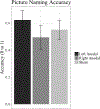Prefrontal transcranial direct current stimulation (tDCS) has a domain-specific impact on bilingual language control
- PMID: 33104382
- PMCID: PMC9473447
- DOI: 10.1037/xge0000956
Prefrontal transcranial direct current stimulation (tDCS) has a domain-specific impact on bilingual language control
Abstract
Researchers debate whether domain-general cognitive control supports bilingual language control through brain regions such as the dorsolateral prefrontal cortex (DLPFC). Transcranial direct current stimulation (tDCS) is a method to alter brain activity, which can lead to causal attribution of task performance to regional brain activity. The current study examined whether the DLPFC enables domain-general control for between-language switching and nonlinguistic switching and whether the control enabled by DLPFC differs between bilinguals and monolinguals. tDCS was applied to the DLPFC of bilingual and monolingual young adults before they performed linguistic and nonlinguistic switching measures. For bilinguals, left DLPFC stimulation selectively worsened nonlinguistic switching, but not within-language switching. Left DLPFC stimulation also resulted in higher overall accuracy on bilingual picture-naming. These findings suggest that language control and cognitive control are distinct processes in relation to the left DLPFC. The left DLPFC may aid bilingual language control, but stimulating it does not benefit nonlinguistic control. (PsycInfo Database Record (c) 2021 APA, all rights reserved).
Figures





Similar articles
-
The Role of the Dorsolateral Prefrontal Cortex in Bilingual Language Switching and Non-Linguistic Task-Switching: Evidence from Multi-Voxel Pattern Analysis.Biling (Camb Engl). 2024 Aug;27(4):690-699. doi: 10.1017/s1366728923000834. Epub 2023 Dec 6. Biling (Camb Engl). 2024. PMID: 39583202 Free PMC article.
-
Cathodal transcranial direct current stimulation over right dorsolateral prefrontal cortex improves language control during language switching.Behav Brain Res. 2018 Oct 1;351:34-41. doi: 10.1016/j.bbr.2018.05.026. Epub 2018 May 26. Behav Brain Res. 2018. PMID: 29842915
-
Shining new light on the brain's "bilingual signature": a functional Near Infrared Spectroscopy investigation of semantic processing.Neuroimage. 2008 Feb 1;39(3):1457-71. doi: 10.1016/j.neuroimage.2007.10.017. Epub 2007 Oct 25. Neuroimage. 2008. PMID: 18054251 Free PMC article.
-
Partially shared neural mechanisms of language control and executive control in bilinguals: Meta-analytic comparisons of language and task switching studies.Neuropsychologia. 2022 Jul 29;172:108273. doi: 10.1016/j.neuropsychologia.2022.108273. Epub 2022 May 21. Neuropsychologia. 2022. PMID: 35605683 Review.
-
Neural basis of bilingual language control.Ann N Y Acad Sci. 2018 Jun 19. doi: 10.1111/nyas.13879. Online ahead of print. Ann N Y Acad Sci. 2018. PMID: 29917244 Review.
Cited by
-
General principles governing the amount of neuroanatomical overlap between languages in bilinguals.Neurosci Biobehav Rev. 2021 Nov;130:1-14. doi: 10.1016/j.neubiorev.2021.08.005. Epub 2021 Aug 13. Neurosci Biobehav Rev. 2021. PMID: 34400175 Free PMC article. Review.
-
Bilingualism and Aging: Implications for (Delaying) Neurocognitive Decline.Front Hum Neurosci. 2022 Feb 2;16:819105. doi: 10.3389/fnhum.2022.819105. eCollection 2022. Front Hum Neurosci. 2022. PMID: 35185498 Free PMC article. Review.
-
The Role of the Dorsolateral Prefrontal Cortex in Bilingual Language Switching and Non-Linguistic Task-Switching: Evidence from Multi-Voxel Pattern Analysis.Biling (Camb Engl). 2024 Aug;27(4):690-699. doi: 10.1017/s1366728923000834. Epub 2023 Dec 6. Biling (Camb Engl). 2024. PMID: 39583202 Free PMC article.
-
Do Bilinguals Outperform Monolinguals in Switching Tasks? Contrary Evidence for Nonlinguistic and Linguistic Switching Tasks.Neurobiol Lang (Camb). 2021 Dec 23;2(4):586-604. doi: 10.1162/nol_a_00059. eCollection 2021. Neurobiol Lang (Camb). 2021. PMID: 37214627 Free PMC article.
-
Switching off: disruptive TMS reveals distinct contributions of the posterior middle temporal gyrus and angular gyrus to bilingual speech production.Cereb Cortex. 2024 May 2;34(5):bhae188. doi: 10.1093/cercor/bhae188. Cereb Cortex. 2024. PMID: 38741267 Free PMC article.
References
-
- Abutalebi J, & Green D (2007). Bilingual language production: The neurocognition of language representation and control. Journal of neurolinguistics, 20(3), 242–275. doi: 10.1016/j.jneuroling.2006.10.003 - DOI

